This is part of my “Batman on Film” blog series. To read other entries in this and other Batman-related blog series, head over to my Batman page.
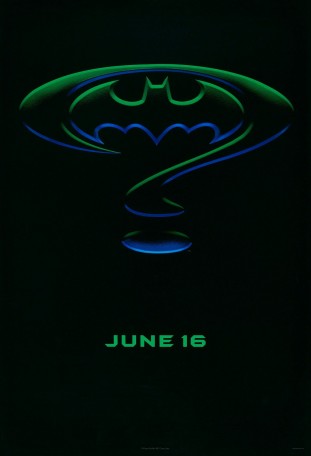 Background & History
Background & History
In 1993, the Batman film franchise faced a turning point. Just four years earlier, Tim Burton achieved the unthinkable: bring a darker, more comic-book-faithful adaptation of Batman to the big screen. But with Batman Returns in 1992, the studio felt the franchise was headed in a very dark direction and wanted to move toward a more “family-friendly” tone. As a result, Burton stepped back into the role of producer, and Joel Schumacher signed on as the director.
Michael Keaton didn’t want to work on a Batman film with anyone other than Burton, so he left the franchise. Val Kilmer was cast in 1994 to take on the iconic role.
Production, Release, and Reception
Filming began in September 1994, and the film released on June 16, 1995. While it surpassed its predecessor in box office intake, the film received mixed reviews with many saying that it lacked the pain and darkness of the first two films while others praised it for the faster pace and better action sequences.
Storyline/Plot
The movie opens with Two-Face robbing a bank and Batman foiling his operation. A Wayne Tech employee named Edward Nygma designs a device that manipulates brainwaves in order to create immersive 3D entertainment. Bruce Wayne denies Nygma any funding due to his misgivings about the morality of manipulating people’s brainwaves. Nygma continues his experiments anyway, and while working on his project, discovers that he can actually gain brainpower from other people’s brainwaves. He then murders his supervisor at Wayne Tech but makes it look like a suicide. Wayne is unconvinced.
Bruce attends a benefit circus with Dr. Chase Meridian, a psychiatrist assigned to the Harvey Dent/Two-Face case, and who also is obsessed with Batman. Two-Face and his henchmen show up at the circus with a bomb threatening to blow everyone up if Batman doesn’t turn himself over to him.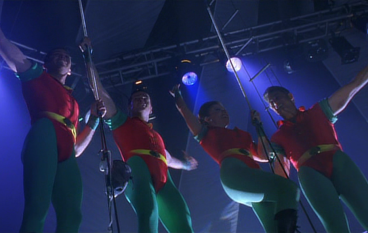
The “Flying Graysons,” a family of trapeze artists, attempt to stop Two-Face. Dick Grayson, the youngest in the family, successfully removes the bomb, but his family is murdered while he’s outside.
Bruce Wayne takes Dick in, and the young Grayson finds his way into the Batcave. He tries to help Batman, and even saves his life at one point, but Bruce decides to give up being Batman for the sake of protecting Dick’s life. Dick, on the other hand, wants to become Batman’s partner for the express purpose of killing Two-Face for his family’s murder.
Visuals/Cinematic Design
Batman Forever is a drastic departure from the design and style of Batman Returns. Where Batman Returns was almost a black-and-white film, Batman Forever is full of bright colors and neon lights. It still plays up the 1940’s art-deco design incorporated in the first two films, even taking it a step further.
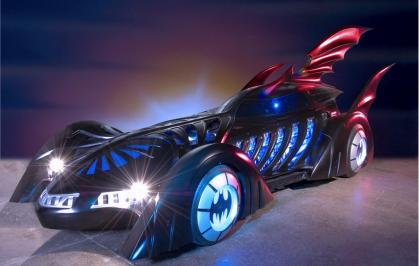 The Batmobile (and other bat-vehicles) gets a major overhaul for this movie. Gone are the shadowy black, sleek steel, panther-like designs of the previous two films. Now the Batmobile (and the Batwing and Batboat along with it) looks like a tiger that ingested a few too many blue LEDs.
The Batmobile (and other bat-vehicles) gets a major overhaul for this movie. Gone are the shadowy black, sleek steel, panther-like designs of the previous two films. Now the Batmobile (and the Batwing and Batboat along with it) looks like a tiger that ingested a few too many blue LEDs.
The Batsuit also received a slight redesign. The main suit Batman wears in the film returns him to the molded look from 1989’s Batman. I was disappointed to see that shift because I loved the Batman Returns plated-armor look. The Batsuit this time around is much sleeker. It’s a lot more form-fitting and streamlined than the previous two Batsuits and would probably be fantastic despite two massive oddities: bat-nipples and bat-ass. Schumacher decided to mold the armor in such a way as to accentuate Batman’s ass crack and added nipples to the Batsuit. I won’t go any further into it lest I get angrier as I type.
Robin’s Batsuit was pretty cool. I liked how it matched Batman’s armor while remaining true to what was introduced in the comic books and modified in Batman: The Animated Series (which is my personal favorite version of Robin’s Batsuit onscreen).
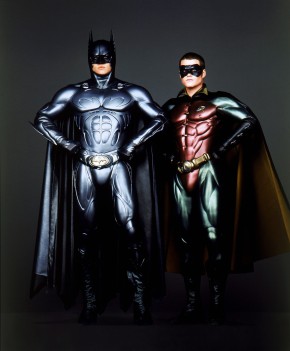 I might be alone in this, but I thought the modified Batsuit that Batman wears at the end of the film is actually pretty cool. I love its sleek design, removal of bat-nipples, and the slight gray tint it has that hearkens back to the black and gray suit Batman wears in the comics and animated show.
I might be alone in this, but I thought the modified Batsuit that Batman wears at the end of the film is actually pretty cool. I love its sleek design, removal of bat-nipples, and the slight gray tint it has that hearkens back to the black and gray suit Batman wears in the comics and animated show.
Main Characters
Batman/Bruce Wayne: Val Kilmer
Val Kilmer’s portrayal of Batman is quite good. While I certainly miss Michael Keaton, I appreciate Kilmer’s approach to Batman’s internal conflict. In his scenes as Bruce Wayne, I found him to be more honest in his characterization and more willing to explore what makes him tick.
Unfortunately, the screenplay included some poor dialogue choices. Kilmer delivers these lines weakly and without conviction, and I can imagine his own turmoil at having to recite lines like, “I’ll get drive-thru,” or “It’s the car, right? Chicks love the car.”
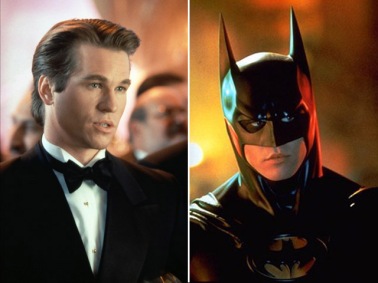 Kilmer’s Batman is the first one where we get to see a glimpse of why he became Batman and what motivates him to continue his crusade against crime. There’s a deleted scene (that I think is crucial and should have been left in) that gives us an even deeper look into what Bruce Wayne is motivated by. Sadly, the crew thought that scene made the movie too heavy, so they cut it out.
Kilmer’s Batman is the first one where we get to see a glimpse of why he became Batman and what motivates him to continue his crusade against crime. There’s a deleted scene (that I think is crucial and should have been left in) that gives us an even deeper look into what Bruce Wayne is motivated by. Sadly, the crew thought that scene made the movie too heavy, so they cut it out.
Overall, Kilmer’s Batman was excellent. He wasn’t as mysterious as Keaton, but some of that might have more to do with the screenplay than with Kilmer’s performance.
Robin/Dick Grayson: Chris O’Donnell
Dick Grayson in this movie is the vehicle for a very complex idea, and Chris O’Donnell does a good job of getting that across. He knows that Two-Face killed his parents, but he doesn’t want to kill him simply because of that. He wants to kill him because he also feels personally responsible for his family’s deaths. In other words, he feels that he could have done something to prevent them, but they were killed any way.
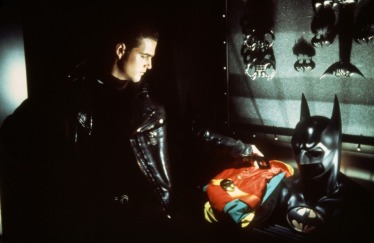 This conflict bleeds over into Batman’s conflict as well. Like Dick Grayson, Bruce Wayne lost his parents to a murderer; and again like Dick, Bruce didn’t do anything to stop it so he feels responsible for their deaths as well.
This conflict bleeds over into Batman’s conflict as well. Like Dick Grayson, Bruce Wayne lost his parents to a murderer; and again like Dick, Bruce didn’t do anything to stop it so he feels responsible for their deaths as well.
Batman got his revenge when Jack Napier died (despite its drastic differences, Batman Forever still exists in the same universe as 1989’s Batman, so Napier was the one who killed Bruce’s parents), and it has only brought him further remorse. He tries to convey this message to Dick, but it only strengthens the young Grayson’s resolve.
Dick Grayson’s journey is one of the more fascinating points of this film, and I’m grateful it was included and fleshed out as well as it was.
Chase Meridian: Nicole Kidman
This character seems like a joke. I don’t think Nicole Kidman did a particularly bad job playing her, but the character appears to exist just because they needed a romance in the movie. She’s a psychiatrist who develops an obsession with Batman that’s 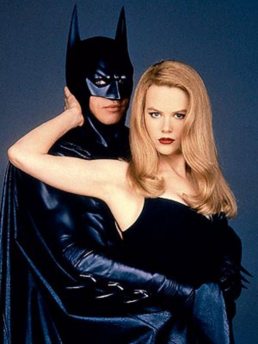 little more than a schoolgirl crush. Her introduction to Batman is so bizarre, and she comes across as continually turned on that it’s a wonder Bruce Wayne could possibly find her attractive as a person.
little more than a schoolgirl crush. Her introduction to Batman is so bizarre, and she comes across as continually turned on that it’s a wonder Bruce Wayne could possibly find her attractive as a person.
She suddenly falls in love with Bruce, but then attempts a midnight tryst with Batman only to tell him that she’s in love with someone else (Bruce).
She’s supposed to be a professional, but she only appears as such in a few scenes. Throughout the movie she just shows up to be a pretty face (no offense to Nicole Kidman of course). I didn’t dislike her, but I didn’t really see the point of her involvement in the film.
The Riddler/Edward Nygma: Jim Carrey
While Jim Carrey’s Riddler wasn’t a terrible character, he was far too much of a Jim Carrey character. In the 1990s, Jim Carrey was the type of actor who needed to be reigned in (unless he was in the right type of movie, of course).
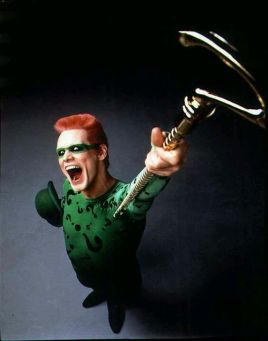 You can certainly see how Carrey took a number of cues from Frank Gorshin’s portrayal of the Riddler, and I’m appreciative of that. He definitely fits in this film, but he’s not as interesting a villain as I had hoped he might become when we were introduced to him.
You can certainly see how Carrey took a number of cues from Frank Gorshin’s portrayal of the Riddler, and I’m appreciative of that. He definitely fits in this film, but he’s not as interesting a villain as I had hoped he might become when we were introduced to him.
His riddles leave a lot to be desired as well; I wish they were more difficult so as to showcase Bruce Wayne’s detective prowess even better. But that’s more the screenwriters’ fault than Jim Carrey’s.
Two-Face/Harvey Dent: Tommy Lee Jones
Two-Face is difficult to understand in this film. According to the comic books, he’s bound to the coin-toss because that’s what he believes true justice is: random happenstance between two options. He even states as much at the beginning of the movie. However, we see him time and time again going against this belief. The core of his character is that an alternate, obsessive personality has taken over Harvey Dent, but his obsessive behavior is more in line with complete comical insanity. He doesn’t truly rely on the coin for anything.
There’s a scene in which Two-Face has the opportunity to shoot Bruce Wayne, but he goes to his coin. This incident is in line with his character; however, he continues to flip the coin when he doesn’t get the desired outcome. For someone who is obsessed with the coin toss, his actions should be dictated by the coin toss. Yet he flips the coin seemingly for no reason because he goes ahead and shoots Bruce Wayne anyway.
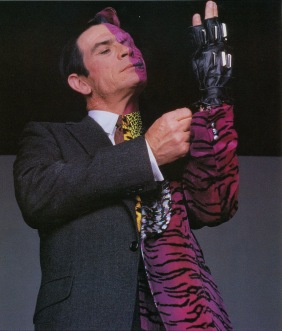 Tommy Lee Jones was pretty bad in this role. It seems like the only type of villain Batman faces in these movies are simply different versions of the Joker. Two-Face spends the whole movie laughing hysterically and whining like a small child. He isn’t the complex character from the comics at all.
Tommy Lee Jones was pretty bad in this role. It seems like the only type of villain Batman faces in these movies are simply different versions of the Joker. Two-Face spends the whole movie laughing hysterically and whining like a small child. He isn’t the complex character from the comics at all.
Granted, Two-Face is an extremely difficult character, and despite how interesting he is, has rarely been handled well by screenwriters and comic book writers alike. Alan Burnett did a good job with him in Batman: The Animated Series, and Christopher Nolan’s approach to Harvey Dent as the tragic hero of The Dark Knight was a novel idea which paid off very well.
This version of Two-Face is annoying, and could’ve been any other Batman villain while still having the exact same impact on the plot.
Alfred Pennyworth: Michael Gough
Once again Michael Gough reprises his role as Alfred, Bruce Wayne’s faithful butler. He had more of a role in this film than in Batman Returns, allowing him to flex his acting muscles a bit more, and the payoff is great. I love how he takes on a fatherly role in Bruce’s and even Dick’s life. He’s clearly much more than just a butler to Wayne Manor—he’s the house’s mentor and dad.
Themes/Motifs
Unlike 1989’s Batman and 1992’s Batman Returns, 1995’s Batman Forever attempts to give its audience more to think about. While it works surprisingly well, the campy atmosphere and silly one-liners really detract from the movie’s thoughtfulness. Additionally, the villains are so over-the-top that they distract the audience from seeing the layers of thematic depth the film presents. Themes like revenge, remorse, and responsibility all swirl through the movie, and they present us with some discussion material afterwards.
Reaction & Impact
I’m rather ambivalent with regards to this film. On the one hand, it leans heavily in the direction of camp, which is something I was thankful had disappeared in Tim Burton’s Batman films. The flashy design, silly one-liners, and over-the-top characterization and plotlines were rather annoying. This was also the movie that introduced bat-nipples and bat-ass, which are unforgivable.
On the other hand, Batman Forever presents some depth of character that was lacking from Batman and Batman Returns. The film attempts to explore Bruce Wayne’s psyche, and while it remains fairly lighthearted, it presents some fascinating material.
Batman Forever serves as something of a soft reboot. It doesn’t entirely do away with story elements and ideas from its predecessors, but it acts as a sort of “start here if you wish” presentation for those unfamiliar with the previous films.
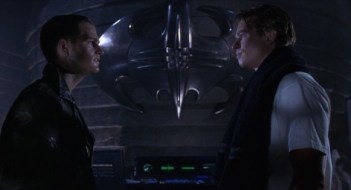 I have to commend this movie for introducing some themes and trying to run with them, despite being relatively unsuccessful. Instead of just tossing superheros and villains into a movie and making them fight (with a dash of romance in there to attract a female audience), Batman Forever gives the audience something to chew on. It’s easy to write a villain who’s out for revenge (which they do with Two-Face and utterly fail), but they also write a protagonist who’s out for revenge, and I have to give them props for that. Dick Grayson’s journey is what propels this film, and it’s actually pretty good.
I have to commend this movie for introducing some themes and trying to run with them, despite being relatively unsuccessful. Instead of just tossing superheros and villains into a movie and making them fight (with a dash of romance in there to attract a female audience), Batman Forever gives the audience something to chew on. It’s easy to write a villain who’s out for revenge (which they do with Two-Face and utterly fail), but they also write a protagonist who’s out for revenge, and I have to give them props for that. Dick Grayson’s journey is what propels this film, and it’s actually pretty good.
I liked the movie to a degree. The villains were weak and annoying. Bruce Wayne’s love interest was frustrating and lacked seriousness. But Dick Grayson’s inner journey and the slight exploration into Bruce Wayne’s motivation are almost worth the price of admission. They don’t cover the multitude of other sins this movie commits, however.
The deleted scene I alluded to earlier was beyond necessary, in my opinion. The scene ties together a number of incomplete plotlines, and gives motivation for Bruce Wayne’s actions in the film. Without it, we’re given almost no explanation for why Bruce decides to become Batman again after “retiring” from crime fighting for a while. It explains why he no longer feels obligated to don the cape and cowl and why he chooses to wear it as part of his identity. It also explains why he brings Dick Grayson on as a partner. Early in the film, Bruce resists the idea of a partner, but by the end of the film he welcomes Dick. Without the scene, the audience has no idea why he changes his mind. I might have considered this a pretty good movie had this scene been left in. Without it, the film is just okay.
Batman Forever is often maligned thanks to its successor, but there’s actually a good story in there with some themes to chew on, halfway decent character development, and tolerable acting. All in all, it’s not as horrible a film as some might remember it as. No, it’s not a great Batman film; it’s not even a that good of a film. Love it or hate it, don’t lump it together with what came next. Batman Forever is definitely worth spending the time to sit down with the movie.